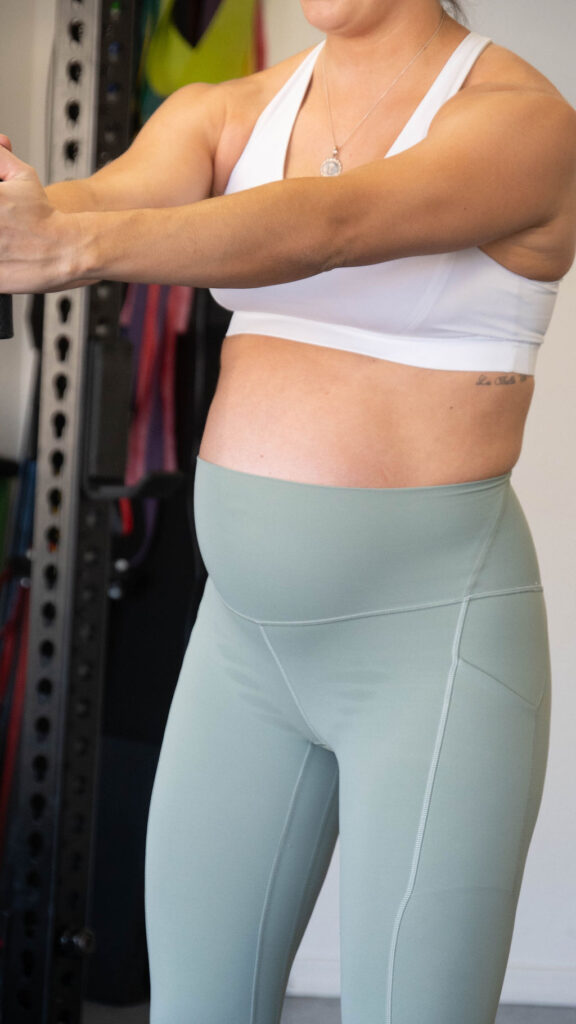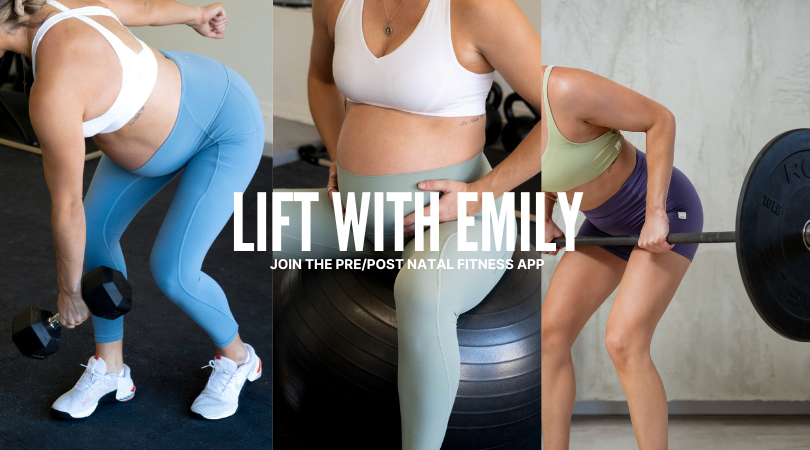
Rotation during pregnancy can be a controversial subject and a simple google search is going to likely tell you to avoid it. However, moving in all planes of motion is key for functional, full body strength as well as for everyday life.
We don’t spend our day moving like robots and only going forward and backwards. You can still a lot of the ‘normal’ things which means you will be rotating and twisting at some point (even if trying to avoid it). For example, If your toddler asks for something form the back seat during a car ride, you are reaching behind you to give it to them. You’re picking up a stroller and rotating to put it in the back of the car. And you’re twisting as you unbuckle your toddler from their car seat, pick them up and place them on the ground or you hip to get them out. This doesn’t change once we’re pregnant and fearing movement is only going to create more stiffness, tension and restriction up or down the chain.
Here is why we need rotation during pregnancy:
Our spine is meant to move, in particular our mid back is meant to rotate. The more movement you have in your upper back, the more space your diaphragm and ribcage have to move and the better you breathe.
The rib cage attaches to the thoracic spine and together form the thorax. On the inhale, the ribs move out and up and on the exhale, the ribs move down and in. This motion is caused by the diaphragm and intercostal muscles contracting and relaxing.
The diaphragm is a muscle at the base of your lungs, attaching to the bottom of the ribs. It flattens as it contracts (inhales) which increases the space to allow for expansion. As it relaxes (exhales) it helps push air out.
When the thoracic spine is tight, it limits rib cage movement. All of the abdominal muscles and scapula muscles attach to the rib cage also. This can also create stiffness through the abs and contribute to poor posture. As a result, this may lead to increased intra-abdominal pressure which can place more pressure and stress on the linea alba and/or pelvic floor. Over time, this can contribute to pelvic floor dysfunction.
Alongside poor pressure management, it can disrupt how the body and muscles work together and cause compensation patterns creating a chain reaction of dysfunction, imbalances, restrictions in mobility, weakness, tension and over working the pelvic floor muscles.
How pregnancy affects the rib cage
As your baby and uterus grow, it pushes up on the diaphragm and forward on to the abdominals to allow for more space for your baby. This can cause the rib cage to be in a constant state on inhalation (expansion) and affect how well the diaphragm can contract and relax. The intercostals also become tight and weak from a lack of mobility.
Postural changes cause a center of gravity shift moving the pelvis into a more anterior tilt. This moves the rib cage slightly backwards and can limit that range of motion further. To counteract this shift, your thoracic spine is put under more pressure to keep you upright which increases the tension through the muscles and joints.
Focusing on including plenty of thoracic mobility – especially rotation – can maintain or improve range of motion, discomfort and encourage more balance amongst these muscles, as well as the muscles of the core.
How to rotate during pregnancy
Correct technique is important. When performing core specific rotation, it’s important to focus on your chest, upper back or hips moving vs just the trunk. This is why we emphasize a lot of thoracic/rib cage mobility.
Our hips are also meant to be mobile. We want to twist, rotate and change directions to be injury and pain free. If we limit this movement, similar to the thoracic spine, that twisting is going to come from the low back to compensate and likely cause some discomfort and/or pain. Also, if your body has been avoiding rotational movement, how well do you think it will handle a sudden movement that you’re doing in your daily life?
Below are some examples of safe thoracic and core rotational movements you can include during your pregnancy.
EXAMPLES OF THORACIC ROTATION: MOBILITY
In a side lying position, place a foam roller between your knees or with your top leg resting at a 90 degree angle and the foam roller underneath. Place you hand behind your head. As you exhale, open the elbow away from your body without moving your lower body as you rotate. Hold at the end range and then return to your starting position.
EXAMPLES OF THORACIC ROTATION: STRENGTH
As you pull back on the side, the opposite arm reaches forward and across to get some upper back rotation. As you back rotates, your hips remain still and in a neutral position. When your elbow cannot go back further without losing tension in your back or rotating your torso, you’ve reached your end range of motion. When you reach this point, squeeze your shoulder blade and maximally contract your back muscles. Inhale to reverse the motion and return to your start position.
EXAMPLES OF ROTATIONAL CORE STRENGTH
Emphasizing thoracic rotation, with slightly hip internal rotation, to create rotation in side plank variation. This may need to be modified if you notice you struggle to manage core pressure.
Start in a side lying position, lift the hips as you exhale and squeeze the ball. Hold in position. From here, rotate your top arm around without loosing your balance, your hips are also slowly rotating with the movement. Return to your starting position without letting your hips roll back and loosing control of your form.
Example of hips, chest and thoracic moving together to create rotation
Step outside foot forward for the staggered stance and keep band midline as you press it away from the chest. From here, rotate towards the anchor point. Make sure your hips are moving with the cable. Rotate as far as range of motion allows.
Everyone moves differently what you can tolerate is individual based on a variety of reasons such as: body mechanics, your understanding of the exercise, how you manage pressure and engage your core or any movement restrictions you may have. How you perform the exercise is what MIGHT make it harmful vs the exercise itself.
That being said, any closed twists with deep abdominal compressing or deep into the lower spine, is likely not going to feel comfortable as your belly grows.

I’m deeply passionate about helping women feel strong, informed, and confident through every stage of motherhood. You deserve more than just a list of do’s and don’ts or generic modifications. With years of hands-on coaching across all kinds of athletes and clients, I blend real-world experience with specialized pre and postnatal knowledge to create strength programs that go far beyond basic adjustments. This is high-level, accessible training - built for your body, your season, and your goals
EXPLORE MORE POSTS